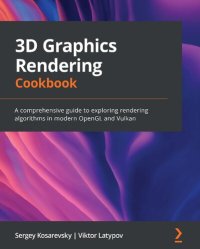
Ebook: 3D Graphics Rendering Cookbook: A comprehensive guide to exploring rendering algorithms in modern OpenGL and Vulkan
Author: Sergey Kosarevsky Viktor Latypov
- Genre: Computers
- Tags: 3D, Graphics Rendering, Rendering Algorithms, OpenGL, Vulkan, Rendering Engine, AZDO, Rendering Pipeline, Real-Time Rendering, Physically Based Rendering, Image-Based Rendering, CPU/GPU Geometry Culling
- Year: 2021
- Publisher: Packt Publishing
- Edition: 1
- Language: English
- pdf
Build a 3D rendering engine from scratch while solving problems in a step-by-step way with the help of useful recipes
Key Features
- Learn to integrate modern rendering techniques into a single performant 3D rendering engine
- Leverage Vulkan to render 3D content, use AZDO in OpenGL applications, and understand modern real-time rendering methods
- Implement a physically based rendering pipeline from scratch in Vulkan and OpenGL
Book Description
OpenGL is a popular cross-language, cross-platform application programming interface (API) used for rendering 2D and 3D graphics, while Vulkan is a low-overhead, cross-platform 3D graphics API that targets high-performance applications. 3D Graphics Rendering Cookbook helps you learn about modern graphics rendering algorithms and techniques using C++ programming along with OpenGL and Vulkan APIs.
The book begins by setting up a development environment and takes you through the steps involved in building a 3D rendering engine with the help of basic, yet self-contained, recipes. Each recipe will enable you to incrementally add features to your codebase and show you how to integrate different 3D rendering techniques and algorithms into one large project. You'll also get to grips with core techniques such as physically based rendering, image-based rendering, and CPU/GPU geometry culling, to name a few. As you advance, you'll explore common techniques and solutions that will help you to work with large datasets for 2D and 3D rendering. Finally, you'll discover how to apply optimization techniques to build performant and feature-rich graphics applications.
By the end of this 3D rendering book, you'll have gained an improved understanding of best practices used in modern graphics APIs and be able to create fast and versatile 3D rendering frameworks.
What you will learn
- Improve the performance of legacy OpenGL applications
- Manage a substantial amount of content in real-time 3D rendering engines
- Discover how to debug and profile graphics applications
- Understand how to use the Approaching Zero Driver Overhead (AZDO) philosophy in OpenGL
- Integrate various rendering techniques into a single application
- Find out how to develop Vulkan applications
- Implement a physically based rendering pipeline from scratch
- Integrate a physics library with your rendering engine
Who this book is for
This book is for 3D graphics developers who are familiar with the mathematical fundamentals of 3D rendering and want to gain expertise in writing fast rendering engines with advanced techniques using C++ libraries and APIs. A solid understanding of C++ and basic linear algebra, as well as experience in creating custom 3D applications without using premade rendering engines is required.
Table of Contents
- Establishing a Build Environment
- Using Essential Libraries
- Getting Started with OpenGL and Vulkan
- Adding User Interaction and Productivity Tools
- Working with Geometry Data
- Physically Based Rendering Using the glTF2 Shading Model
- Graphics Rendering Pipeline
- Image-based Techniques
- Working with Scene Graphs
- Advanced Rendering Techniques and Optimizations